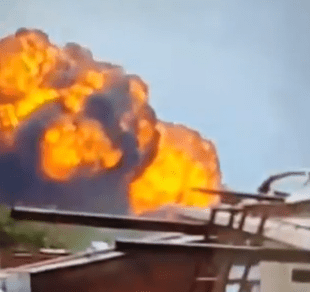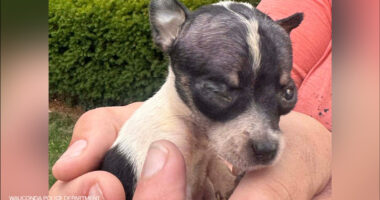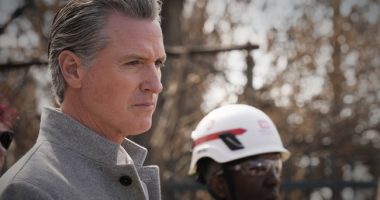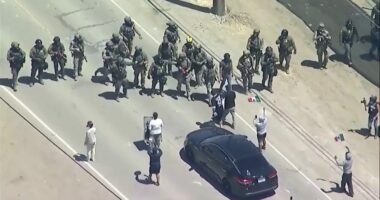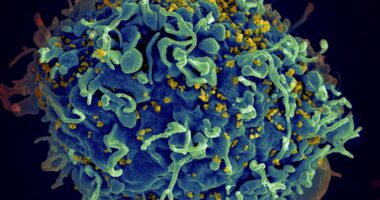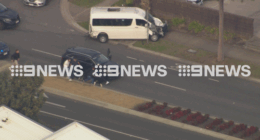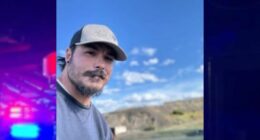Share this @internewscast.com
A PASSENGER plane with 53 Brits on board has crashed into a doctor’s hostel in India.
At least 242 people were on board the Air India aircraft as it smashed into the ground and exploded upon impact near to an airport in Ahmedabad.

The plane was headed to London Gatwick in the UK, Air India confirmed.
It’s understood there were 53 Brits on board, as well as 169 Indian, one Canadian and seven Portuguese passengers, according to a source.
According to flight tracking website Flightradar, the Boeing 787-8 Dreamliner’s final signal was received just seconds after take-off.
This was last logged at 10.08am local time – less than a minute after it started its journey.
It had only reached 625 feet at the time, officials believe.
In a statement the airline said: “Flight AI171, operating Ahmedabad-London Gatwick was involved in an accident on 12 June 2025.
“At this moment, we are ascertaining the details and will share further updates at the earliest opportunity.”
Police said the plane crashed into a “civilian area” in Meghaninagar.
Officials are yet to comment on if there are any casualties.
The aircraft was attempting to take off from Ahmedabad Airport when it crashed, local TV channels reported.
A fireball explosion is said to have erupted near to the airport as footage shows thick plumes of black smoke quickly pouring into the skies.
The Ahmedabad Fire and Emergency Services Department quickly deployed over five fire-fighting teams to the site as well as dozens of ambulances.
Ram Mohan Naidu Kinjarapu, the Civil Aviation Minister, said in a statement: “Shocked and devastated to learn about the flight crash in Ahmedabad.
“We are on the highest alert. I am personally overseeing the situation and have commanded all aviation and emergency response teams to execute immediate and coordinated action.
“Rescue teams have been mobilised, and all efforts are being made to ensure medical aid and relief support are being rushed to the site.
“My thoughts and prayers are with all those on board and their families.”
It is still unclear what caused the disaster.
Read our live blog on the Air India plane crash…
-
Air India plane crashed on a hostel building for doctors
The Air India plane crashed into a hostel building for doctors, a police official has said.
-
Some other airline accidents in India in recent decades
August 2020: At least 18 people lost their lives and 16 sustained serious injuries when an Air India Express Boeing 737 aircraft veered off the runway in the southern city of Kozhikode amidst heavy rain, plunged into a valley, and crashed nose-first into the ground.
May 2010: An Air India Boeing 737 flight arriving from Dubai overshot the runway at the airport in the southern city of Mangaluru and crashed into a ravine, resulting in the deaths of 158 individuals on board.
July 2000: More than 50 people were killed when a state-owned Alliance Air flight between Kolkata and the capital, New Delhi, crashed in a residential area of the eastern city of Patna.
-
Crashed flight ‘had 53 British, 169 Indian, 1 Canadian and 7 Portuguese passengers’ – source
There were 53 Brits on board, as well as 169 Indian, 1 Canadian and 7 Portuguese passengers.
-
Pilot ‘made mayday signal’ before crash
The pilot managed to make a mayday call before crash, according to aviation expert Julian Bray who spoke to Sky News.
This reportedly means the crew would have been aware of an issue prior to the incident happening.
-
All Ahmedabad airport flights suspended
Ahmedabad airport has suspended all its flights until further notice and is not operational, a spokesperson from the Sardar Vallabhbhai Patel International Airport in Ahmedabad said.
-
232 passengers and 12 crew on board – official says
The plane crashed into a residential area called Meghani Nagar with 232 passengers and 12 crew members on board, according to Faiz Ahmed Kidwai, chief of India’s directorate of civil aviation.
-
‘First ever’ Boeing 787 crash
This is the first ever crash of a Boeing 787 aircraft, according to the Aviation Safety Network.
The Boeing 787-8 Dreamliner heading to London that crashed has a total of 256 seats, according to SeatGuru.
It was scheduled to land at 18:25 at Gatwick.
-
Gatwick Airport confirms plane was due to land in London
In a statement on X, Gatwick Airport said: “We can confirm that flight AI171 that crashed on departure from Ahmedabad Airport today was due to land at London Gatwick at 18:25.”
-
‘We are on highest alert’ says minister
India’s aviation minister Kinjarapu Ram Mohan Naidu said: “We are on highest alert.
“I am personally monitoring the situation and have directed all aviation and emergency response agencies to take swift and coordinated action.
“Rescue teams have been mobilised, and all efforts are being made to ensure medical aid and relief support are being rushed to the site.
“My thoughts and prayers are with all those on board and their families.”
-
India’s aviation minister ‘shocked and devastated’ by crash
India’s Aviation Minister Kinjarapu Ram Mohan Naidu has said he is “shocked and devastated” at the plane crash in Ahmedabad.
-
Plane has 256 capacity – SeatGuru said
The Boeing 787-8 Dreamliner heading to London that crashed has a total of 256 seats, according to SeatGuru.
It was scheduled to land at 18:25 at Gatwick
-
Plane crashed in fireball ‘outside airport perimeter’ – reports
India’s aviation regulator has said the plane crashed after take-off “outside the airport perimeter”.
Up to 242 people were on board the Air India aircraft as it smashed into the ground near to an airport in Ahmedabad.
The plane was headed to London Gatwick in the UK, Air India said.
-
Signal from plane lost at 625ft – Flight Radar
Flight tracking website Flight Radar has said that the Air India flight was to fly from Ahmedabad International Airport to London Gatwick Airport at 09:50 local time, landing 18:25 local time.
The signal was lost at 10:08 local time at 625ft – less than a minute after take off, Flight Radar said on X.
The website earlier said that the last signal from the plane was received seconds after take off.
-
Air India statement following crash
Air India posted on X: “Flight AI171, operating Ahmedabad-London Gatwick, was involved in an incident today, 12 June 2025.
“At this moment, we are ascertaining the details and will share further updates at the earliest.”
-
Rescue teams mobilised says India aviation minister
India’s aviation minister has said “we are on highest alert” and that “rescue teams have been mobilised” following the crash.
Up to 242 people were believed to have been on board the Air India aircraft as it smashed into the ground at an airport in Ahmedabad.
-
Plane appears to have crashed in residential area
The passenger plane headed for London appears to have crashed in a residential area, according to videos on social media.
A fireball explosion is said to have erupted at the airport as thick plumes of black smoke quickly poured into the skies.
-
Last signal received seconds after take off – Flight Radar
Flight tracking website Flight Radar has said that the last signal from the plane was received seconds after take off.
It posted on X: “We are following reports of a crash of Air India flight #AI171, external from Ahmedabad to London.
“We received the last signal from the aircraft at 08:08:51 UTC, just seconds after take off.”
